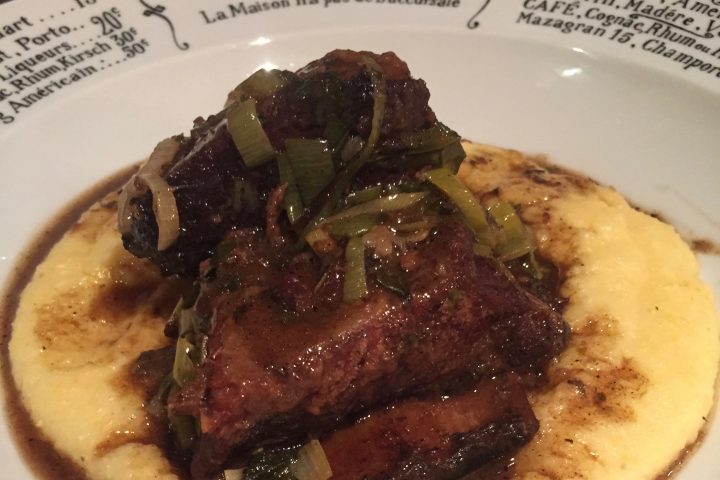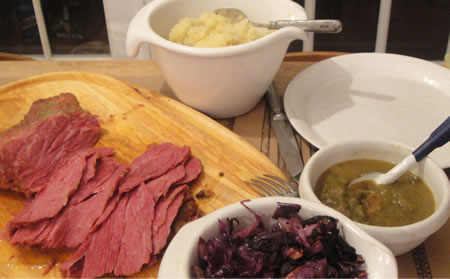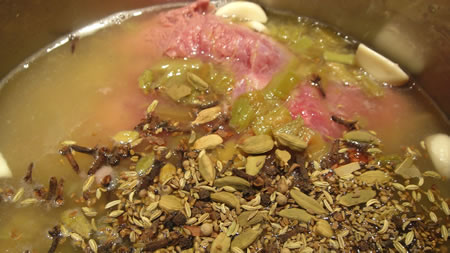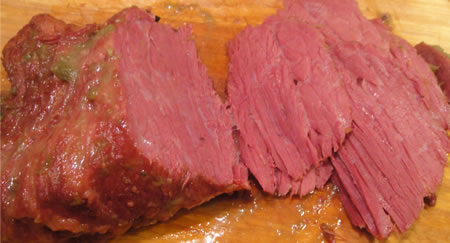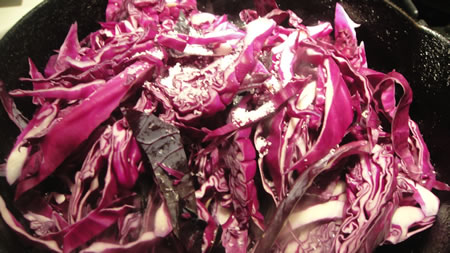From Beef
Water Buffalo or Beef Short Ribs Perfection for an Early Spring
Short Ribs are one of my favorite meals. I usually make them on a special occasions. And with two snow storms behind us and one looming in our future I think three snow storms in April constitutes something special.
Tom Brady’s Perfect (Meat) Balls:
Try these Perfect Meat Balls! I use veal or a 50/50 mix of lamb and veal with left over brioche from the She Wolf Bakery. Laura O’Brien, Josephine Feast!
My Goodness, My Guinness Stew
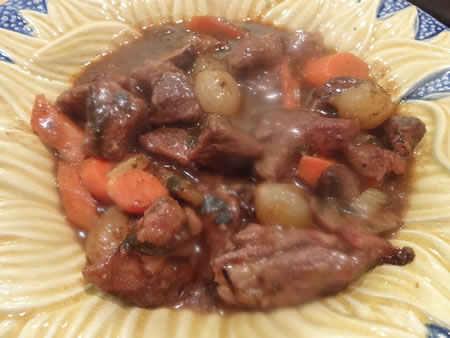
March is here and Spring is in the air – or is it? Having another long cold saturday in front of me, I decided to turn on the oven and celebrate the glimmering hints of Spring by raising a strong cup of tea to St Patrick and the Irish – Peter O’Toole, Gabriel Byrne, Liam Neeson, Jonathan Rhys Meyers and even Colin Farrell. With a Dexy’s Midnight Runner’s song playing in my head, and the sound track of Barry Lyndon playing in my heart – I began to make my “almost” famous Guinness Stew. I found this recipe in a 1980‘s edition of Food & Wine and over the years I have tweaked and redefined the flavors to made this stew my own. My friend Anita – who shared the same love of the Irish with me, would poetically describe the flavor of the mushrooms to our foodie friends – Joyce couldn’t have done any better. She was always invited to our St. Patricks Day dinner as she was a dear, dear friend who loved Irish music, Irish men and “real” Irish stew just as much as I do.
This recipe makes enough for 8. I make this quantity so that you will have leftovers to freeze for an impromptu Sunday night supper. It is a simple stew that benefits by slow and thoughtful cooking as well as a “rest” in the fridge for a day or two. It gives a chance for the flavors of the spices to blend.
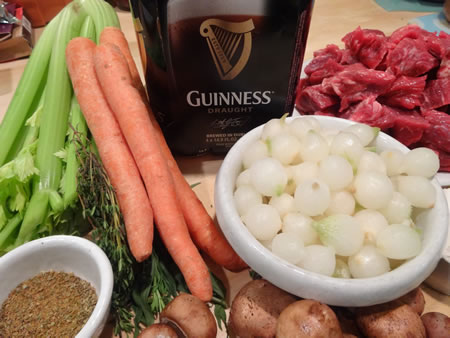
Ingredients:
4 lbs. beef stew
6 T or more olive oil
2 lbs. white button mushrooms
1 lb. frozen pearl onions onions (as much as I love the baskets of fresh pearl onions – the frozen will save you time and is equally as good in the stew.)
4 carrots – give or take
4 ribs of celery
1 cup or more of flour
Sea Salt
2 t Quatre Epice (mix equal parts of cloves, ginger, nutmeg & black pepper)
2 12 oz cans of Guinness Stout (buy the 4 pack and enjoy the pour.)
1/3 cup ketchup – or if you prefer tomato paste which was what the original recipe called for. ( I have no problem with ketchup after using it as an integral ingredient in David Bouley’s crab salad while working as Garde Manger at the 4 star restaurant.)
1 T Herbes de Provence – (an mix of savory, marjoram, rosemary, thyme, oregano & sometimes lavender)
A spice bag consisting of:
2 bay leaves, 1 t celery seed, 1/2 t mustard seed, 2 cardamon pods,6 all spice seeds, 6 white & 6 black peppercorns, 4 cloves, small piece of nutmeg, slice of ginger, pinch of red pepper flakes
OR
2 T Josephine’s Fest Shinnecock Bay Spice Rub
pre-heat oven to 350 degrees
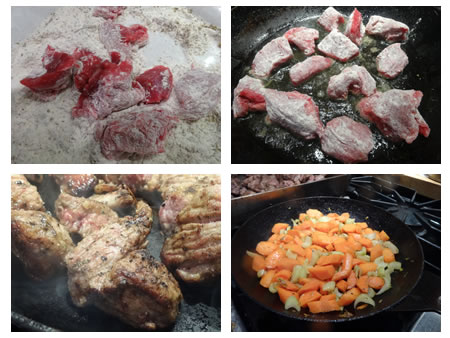
First trim the stew meat. I like to cut my pieces into something that sits on a spoon – usually 1/3 the size of what my butcher provides.
Stem the button mushrooms and cut the caps into slices – I only use the caps saving the stems for a mushroom stock.
Peel the carrots and cut in half lengthwise and slice into 1/2’’ slices. Do the same with the celrey. Reserve the pearl onions.
Make a dredge using a bit more than a cup of flour, a good pinch of sea salt and 1 t Quatre Epice
Heat 2 T of the olive oil in a heavy cast iron pan. When very hot and smoking, quickly dredge a hand full or two of the stew meat in the flour and sear on all sides. Work quickly and in small batches using a bit more oil if needed. The end result should be a juicy stew without steaming the meat in it’s own juice. The object is to caramelize a “crust”. Work your way through all the beef in small batches. Reserve.
While the meat is resting – add 2 T of olive oil to your roasting pan and place it on the stove. Sauté the carrots & celery with a pinch of salt for 3 to 5 minutes. Then add the mushrooms. Once again – allow the carrots & mushrooms to cook and caramelize without steaming. About 6 to 8 minutes.
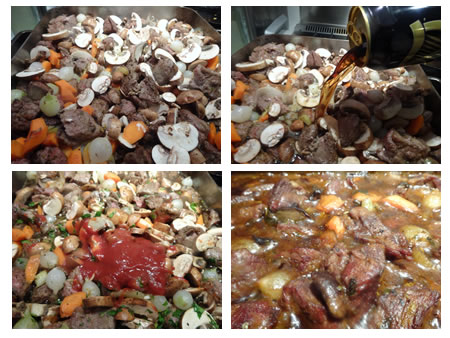
Add the stew meat and the onions. And two cans of Guinness Stout and 1/3 cup of ketchup. Scrape any bits that may be on the bottom of the pan.
Add a Bouquet Garni – a cheese cloth tie made of 2 bay leaves, 1 t celery seed,1/2 t mustard seed, 2 cardamon pods, 4 all spice seeds, 6 white, 6 black peppercorns, 2 cloves, small piece of nutmeg, slice of ginger, pinch of red pepper flakes.
Cover and roast in the oven at 350 degrees for 2 to 3 hours.
When finished test for seasoning. A bit of salt can be added to taste.
This stew benefits by a long slow roast and is particularly good the second day so it is a terrific make ahead meal.
This stew is great with egg noodles or mashed potatoes. But for a truly remarkable meal why cook up a pot of polenta while the stew is finishing? Although this a a non-traditional accompaniment – it is immensely delicious and satisfying. The leftovers can be rolled into a log – wrapped and refrigerated over night. It is a perfect sliced and grilled to serve alongside the leftover stew.
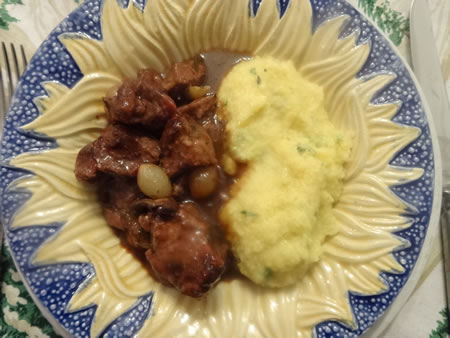
Cooking with Fire: The Ultimate Cowboy Steak
We are very lucky indeed. Our country home has an fire pit fitted with an outdoor grill. It overlooks Shinnecock Bay and the cool spring evenings are perfect for watching a moonrise and sipping a martini.
Another perk is the ability to cook over an open fire all year round. A quick steak with a salad and oven fries is our usual Saturday night fare. Something delicious, easy and spontaneous that can serve my family of 3 or a feast for more if friends drop by.
One of my favorite cuts of meat is a shell steak – so I was pleasantly surprised when Andrea Geary wrote about it in the June edition of Cook’s illustrated. Although I always rub my steak with a simple version of green herbs, fresh garlic, olive oil and salt or a spicy chili rub when company calls, she suggested spicing things up with a quick glutamate paste of fish sauce, tomato paste, onion & garlic powder, and salt for one hour before cooking. She was playing with the Fifth Taste, Umami – something my father would do without knowing, when he added Worcestershire Sauce to every meal. I was intrigued.
Simply – the steak is scored with a shallow slits and let sit in a marinade for 1 hour. This glutamate or Umami “marinade” changes the structure of the muscle fibers of the protein so that they hold on to more juices and it is hardly detectable to the taste. When the rub is added and the steak put to the flame, you have a wonderful, tender, delicious steak that any cowboy would be glad to call dinner.
I must say this is a step I have never tried and it makes a big difference.
Grilled Steak with Chili & Espresso
2-3 Shell Steaks
Marinade:
2 t tomato paste
2 t fish sauce
1 1/2 t natural sea salt – or kosher salt although I prefer sea salt
1/2 t onion powder – something I never use but stay with me
1/2 t garlic powder – again, something I never use but it will make a difference
Spice Rub:
2 Dried New Mexican Chilies – you can substitute an Ancho Chile if you dare
4 t whole cumin seeds
4 t coriander seeds
1/2 t cayenne pepper flakes
1/2 t black pepper – tellicherry peppercorns is my choice
1 t organic sugar
1 t finely ground espresso coffee
1t smoked paprika – hot paprika can be substituted but the smoked adds a depth of flavor
1/4 t cloves
Vegetable oil spray:
- With a sharp knife make 1/16” slits 1/2” apart in a diamond pattern on both sides of the steak.
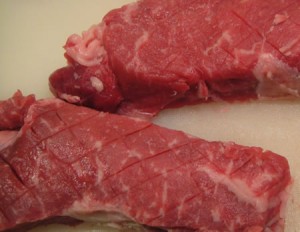
- Make the ‘marinade” by mixing all ingredients and rubbing the paste into the steak.
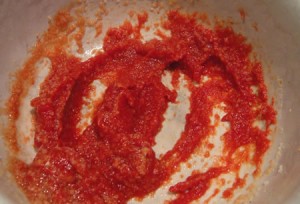
- Let sit for one hour at room temperature
- Prepare the fire 30 minutes before grilling
- Make the spice rub by toasting the first 5 ingredients for 3 to 5 minutes in a hot cast iron pan. Be care to use a vent or keep a window open as the hot pepper can cause your eyes to tear.

- Cool in an open bowl and add the final 4 ingredients. Grind with a spice grinder or a mortar and pestle. If you prefer a chunky rub.
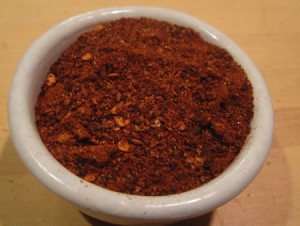
- Press 1/2 of the spice rub onto the tops of the steaks and spray with a light coating of vegetable oil. do the same to the second side.
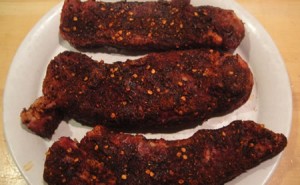
- Cook over a hot fire until brown and charred – about 3 to 4 minutes per side. The steak should register at 125 to 130 degrees for medium rare.
- Tent with aluminum foil for 10 minutes – this is an important step that is often forgotten.
- Slice thin against the grain
Corned Beef with Rhubarb Sauce
The winter seems to have passed with out much notice here on the east coast. There was no snow to speak of and my garden soil never froze. In fact I have 5,000 pot holes where a gang of very fat squirrels have dug up and eaten all of my spring bulbs. The funny thing is – I have a Feist – a dog that is bred to hunt squirrels in trees. Both George Washington and Thomas Jefferson had such dogs and wrote fondly of their hunting skills. But my dog “Lucky” has been reduced to fear – hiding under a bush in the corner of the garden as the gang of squirels – who are far to big too climb the trees – – picnic on my bulbs.
But there is always hope in the early spring garden. My witch hazel is in full bloom, as is the crocus and the snow drops. Before you now it the apples will be in blossom and the rhubarb will be poking out of the soil. Maudy Tuesday has passed and St Patricks day is right around the corner. Corn beef and cabbage is a spring tradition in the O’Brien household and I take a very unconventenial approach to my preparation having had many boiled dinners in my life.
I look forward to celebrating St Patrick’s Day with this dinner each year. The recipe is flavorful and surprisingly lean with a nod to a tradition. The beauty of the dinner is the flavorful rhubarb sauce accompinied by smashed yukon gold potatoes and sauted red cabbage and garlic. it is just about the most perfect perfect way to welcome spring.
This dinner takes a bit of planning but is well worth the effort. Corned beef is a type of salt-cured beef. The term comes not from the grain corn, but from the treatment of the meat with “corns” of salt. Due to the ubiquity of salting beef for preservation in many cultures, corned beef features prominently as an ingredient in many cuisines, including the Jewish, Irish American, and Caribbean cuisines. First order a thick cut organic corned beef preferably with no nitrates. Worth the trouble, potassium nitrate is added to keep the meat a bright pink color – I’d rather do without it. Whole Foods or Natures Way feature several organic – no nitrate brands.
Corned Beef with Rhubarb Sauce
4 to 5 lb Corn Beef – preferably organic with no nitrates
4 to 6 cups apple cider
2 lbs fresh or frozen rhubarb – cut into 1” pieces
2 T Garam Marsala Spices
First trim every visible piece of fat off the corned beef. Some of you may not agree – but there is enough fat between the meat to keep the corned beef tender.
Pour 4 cups of apple cider – enough to cover the corned beef in a dutch oven. Add 1/2 the chopped rhubard.
Heat the liquid and add the trimmed corned beef and the rest of the rhubarb.
Sprinkle in 2 T of the spice mix. Cover and cook on a medium heat until the “sauce” spits and boils.
Uncover and simmer for 60 to 90 minutes until all the fat is rendered off the corned beef and your rhubarb sauce is as thick as custard.
Take the meat from the pot and let it rest “tented” under foil for 10 minutes. The apple cider and rhubarb tenderize the meat in the cooking process.
When serving, slice the corned beef at a severe angle and serve with rhubarb sauce and dijon mustard.
Leftovers make excellent open face sandwiches.
Smashed Yukon Gold Potatoes
3 pounds of Organic Yukon Gold Potatoes
2 T butter – I prefer Organic
1/2 to 1 cup of milk – I prefer Organic
Natural Sea Salt
White Pepper
Fill a 4 qt pot with water. Add a generous pitch of natural sea salt
Wash and quarter the potatoes
Boil the potatoes until fork tender – about 30 minutes
Drain the pot of the boiling water and it place back on a very gentle heat to dry the pot and potatoes.
Add 2 T unsalted butter – cut these into small pieces to melt quicker
Smash the potatoes with an old fashioned potatoe masher.
Slowly add milk while continuing to smash the potatoes – Yukon Golds are surprisingly soft and creamy – you really won’t need much milk
Test for salt and add some white pepper
Other variations:
If you would like you can add a few cloves of garlic to the boiling water to make a Garlic Smashed Potatoes
If fresh herbs are on hand, a generous sprinkling of finely chopped parsley adds a fresh flavor.
If calories are not an issue – salt pork or bacon is a wonderful old world addition
Red Cabbage Sauted with Garlic
One of the easiest vegetables is sliced red cabbage sauted with garlic – the color looks glorious and the flavor is tastefully delicious
1/2 a head of Red Cabbage
Natural Sea Salt
Garlic
Olive Oil.
The trick here is to slice the cabbage as fine as you can – a rough chop is fine but for a truey spectacular dish use a mandoline or cuisinat with a fine shreadding disk
Add enough olive oil to just about cover the bottom of a cast iron frying pan.
Add 4 to 6 chopped cloves of garlic – cook until lightly gold – don’t over cook
Add the red cabbage and a good pinch of salt
Saute – turning every few minutes on medium heat.
Cook until tender and when the cabbage is slightly limp.
